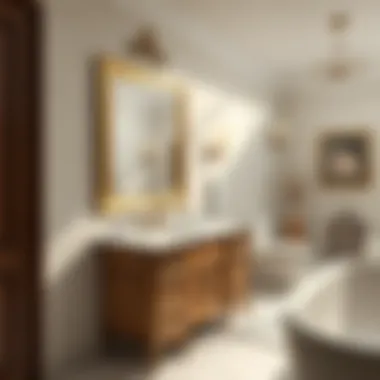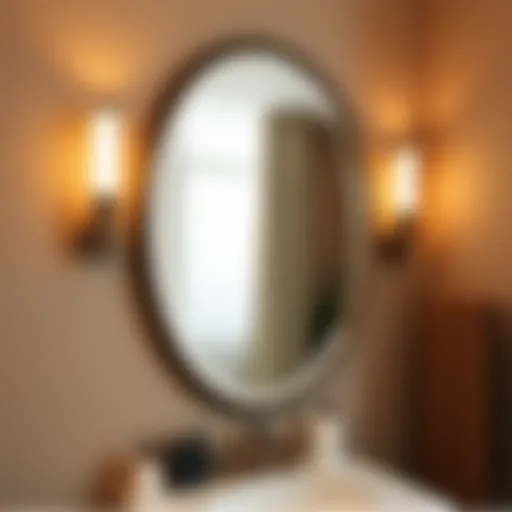Determining the Right Size for Your Bathroom Vanity


Intro
When it comes to designing a bathroom, one of the most crucial elements to consider is the size of the bathroom vanity. The vanity is not just a piece of furniture; it plays a pivotal role in how the space is perceived and functions. It can impact everything from storage capability to the overall flow of movement within the room. It’s a balancing act—a dance between personal style and practical limitations.
Designing a bathroom always starts with understanding the space. This isn’t merely a matter of choosing a design that appeals visually; one must take precise measurements and evaluate how the vanity complements existing features like sinks and mirrors. Whether you have a snug alcove or an expansive suite, knowing the right size is key to crafting a functional yet stylish environment.
In this guide, we will explore various factors that influence vanity size, and provide critical insights into making the best choice for your needs. You will learn about standard dimensions, the benefits of custom options, and more, ensuring that you are well-equipped to enhance your bathroom experience.
Design Inspirations
Modern vs. Traditional Bath and Bedroom Styles
The design of your bathroom is closely tied to your personal taste and the overall look you want to achieve. In modern designs, the focus typically leans toward simplicity and clean lines. Think sleek vanities with minimalist hardware and rich, glossy finishes. On the other hand, traditional styles often feature more intricate details, with wood finishes that evoke warmth and familiarity.
A modern vanity might consist of angular shapes and bright colors, establishing a fresh vibe, while a traditional one could have ornate carvings and a deep, rich stain that tells a story of craftsmanship. When selecting a vanity, consider how it will align with other bathroom elements, from tiles to wall colors. Your choice can indeed set the tone for the entire space.
Color Palettes and Textures
Once you have an idea of the style, next comes color palettes and textures. The hue of your vanity can dramatically affect the mood of the room. Soft pastels might lend a calm and relaxing feel, while bold, dark colors can create a sophisticated, dramatic effect. Pairing textures also invites an interesting dimension. A smooth-gloss vanity paired with rough stone tiles can create an appealing contrast.
Don’t shy away from mixing materials either. For instance, combining a wooden vanity with stainless steel fixtures can blend styles in a way that looks effortless. Here are some combinations to consider:
- White Vanity: Brightens a small space and pairs well with virtually any color scheme.
- Natural Wood: Adds warmth and complements earthy tones.
- Black Vanity: A bold choice that sits strikingly against light color palettes.
- Colored Finishes (Sky Blue, Emerald Green): Infuses personality and works beautifully with neutral walls.
"Style is a reflection of your attitude and your personality." - Shawn Ashmore
In summary, explore how modern and traditional elements can work together in your design ideas, and be sure to give adequate consideration to color and texture. This ensures your choice of vanity not only amplifies functionality but also elevates the overall aesthetic appeal of your bathroom.
End
Choosing the right size bathroom vanity requires a thoughtful approach to design and functionality. By considering your style preferences, color choices, and how it works within your space, you will be better prepared to find a vanity that will serve your needs for years to come. Don’t hesitate to explore custom options for a truly tailored fit. This journey into understanding bathroom vanity size is just the start of creating a space that feels right for you.
For further information, consider checking out resources from Wikipedia and Britannica.
Engage with communities that share your thoughts on design at Reddit or Facebook.
By taking these key considerations into account, you’re on the right path to designing a bathroom that’s not just functional but also a true expression of yourself.
Intro to Bathroom Vanity Size
Choosing the right size for a bathroom vanity is not merely a matter of aesthetics; it’s a crucial part of a well-functioning bathroom design. This discussion will explore the inherent significance of vanity size, focusing on how it influences both the look and practicality of the space.
Definition of Bathroom Vanity
A bathroom vanity typically includes a cabinet that houses a sink, along with a countertop. These units can vary greatly in size, style, and function, serving as both a storage solution and a focal point in bathroom decor. Essentially, the vanity acts as the cornerstone of bathroom functionality. Depending on the setup, it can include drawers, shelves, and sometimes even integrated mirrors or lighting. The choice of vanity size directly affects how well these functionalities align with the available space and the needs of the user.
Importance of Vanity Size in Design
The size of the vanity plays a pivotal role in creating a harmonious and functional bathroom. Here are a few key points to consider:
- Space Efficiency: Via smart sizing, homeowners can maximize their usable area. A too-large vanity can cramp a small bathroom, creating an uncomfortable experience.
- Aesthetic Flow: The vanity size must complement the overall design style. A large, ornate vanity might feel out of place in a minimalist space, while a small, sleek unit could look lost in a grand setting.
- User Experience: For households with multiple users, a generous size can cater to everyone's needs, offering ample countertop space and storage for personal items. Conversely, single-user situations might afford smaller dimensions without sacrificing functionality.
"A well-chosen vanity size enforces organization, promotes ease of use, and ultimately, enhances the overall bathroom experience."
These considerations underscore the importance of calculating the appropriate vanity size. It is a decision that not only impacts styling but also addresses usability, convenience, and comfort in daily routines. Having a comprehensive understanding of your options empowers you to make choices that align with your lifestyle and preferences.
Factors Influencing Vanity Size Selection
Choosing the right bathroom vanity isn’t just about aesthetics; it directly impacts functionality. Factors influencing vanity size play a major role in ensuring that the vanity fits well within the space and meets the user’s needs. Users must consider their daily routines, how many people will use the bathroom, and the specific layout of their space. A thoughtful approach not only enhances the bathroom's appearance but also improves its usability, making it a more pleasant environment for daily activities.
Available Space Considerations
Measuring Bathroom Dimensions
Measuring bathroom dimensions is a critical first step in selecting a vanity. Before diving headfirst into designs and colors, knowing how much space you have is key. This measurement ensures that the vanity chosen does not overwhelm or underwhelm the area. For instance, if a homeowner has a compact bathroom, going for a bulky piece can make the space cramped and uncomfortable. Conversely, a more petite vanity can sometimes give the illusion of more space, which is particularly beneficial in smaller setups. Hence, getting it right can lead to easier mobility and a more open feel.
Assessing Floor Plan Layout


Assessing the floor plan layout adds another layer of consideration. It's vital to analyze not just the dimensions but how the existing features like windows, doors, and other fixtures interact with the vanity space. This evaluation allows homeowners to visualize the flow of movement in the bathroom, ensuring that the layout facilitates convenience. For example, keeping a clear pathway to the shower or toilet while accommodating a larger vanity could provide that crucial balance of style and function. Moreover, understanding the floor plan can help when deciding on whether a wall-mounted or freestanding vanity will work best.
User Needs and Preferences
Number of Users
The number of users is a vital factor when choosing a vanity size. For households with multiple people sharing the space, a double sink vanity often becomes a necessity. Having two sinks allows for more efficiency during busy mornings when everyone is trying to get ready. Additionally, it alleviates the stress of waiting, making mornings smoother for families. However, for single users or couples with minimal needs, a single sink vanity could be adequate and leaves more room for storage or decorative elements.
Storage Requirements
Storage requirements are just as crucial as the number of users. Different households have varying needs for storage based on the number of products used. For those who enjoy a routine of using numerous grooming products, ample storage becomes paramount. A spacious vanity can feature a combination of drawers and cabinets, creating an organized and accessible area. On the flip side, minimalists may find that a smaller vanity aligns better with their lifestyle, requiring fewer products and therefore less storage. Balancing this aspect helps in creating a functional and appealing bathroom.
Style and Design Trends
Modern vs. Traditional
Exploring modern and traditional styles shows how each can influence vanity size decisions. A modern vanity, often characterized by sleek lines and minimalistic features, works well in contemporary spaces. These vanities tend to be simpler in design, often giving an airy feel that pairs well with open layouts. In contrast, traditional styles bring in ornate details and rich finishes, which can sometimes demand more physical space to accommodate these elaborate designs. Choosing between these styles affects not only the visual appeal but also the appropriate size of the vanity itself, guiding homeowners in their selections.
Minimalist vs. Ornate Designs
The choice between minimalist and ornate designs further illustrates how style affects size. A minimalist design promotes clever usage of space, focusing on functionality without compromising on aesthetics. This choice naturally leads to smaller, more streamlined vanities, suitable for those who prefer clean lines and open areas. On the other hand, ornate designs often require larger vanities to fully display their craftsmanship and decorative elements. While these may add an impressive statement to the bathroom, they can also occupy valuable floor space. Evaluating these design preferences is crucial to finding a vanity that fits both the space and the homeowner's personal style.
In sum, determining the factors influencing vanity size selection provides insight into creating a functional bathroom space that meets users' needs while harmonizing with design trends.
Standard Bathroom Vanity Sizes
Understanding the standard sizes of bathroom vanities is crucial. It allows homeowners to create spaces that balance both functionality and aesthetics, making the bathroom a serene retreat. The right vanity size can enhance the overall design, ensuring that it fits seamlessly into the layout of the room. Additionally, knowing standard sizes helps to make more informed decisions when purchasing or customizing vanities to suit individual needs.
Single Sink Vanities
Single sink vanities are popular choices for smaller bathrooms or powder rooms. They offer a straightforward solution without sacrificing style.
Common Widths
When it comes to common widths, single sink vanities generally range from 24 inches to 60 inches. This variety in size allows homeowners to select a vanity that best fits their unique space. A 36-inch vanity is often favored as it provides enough countertop area while still being compact enough for smaller bathrooms. Modern aesthetics often lean toward these widths because they strike a balance between convenience and space efficiency. However, it’s essential to keep in mind that a narrower vanity might limit storage options.
Depth Measurements
Depth measurements typically hover around 18 to 21 inches for single sink vanities. This depth allows enough surface area for everyday tasks without overwhelming the visual space of the bathroom. Choosing a deeper vanity can offer additional surface area, which can be handy for toiletries and accessories, though it might encroach on the pathway in a tighter room. A traditional 20-inch depth often finds favor, as it comfortably accommodates necessary plumbing.
Double Sink Vanities
Double sink vanities are ideal for shared spaces, minimizing morning rush hour frustrations in the bathroom.
Benefits of Larger Sizes
The principal benefit of larger double sink vanities is the increased utility. Sizes often start at 60 inches and go all the way up to 72 inches or more. By accommodating two sinks, couples can enjoy their own designated spaces, making morning routines smoother. This size allows for extra countertop space, which is particularly useful for families who need room for moving about or laying out personal items. However, larger sizes could require additional considerations for plumbing and layout.
Variations in Width
Wide double sink vanities can feature a range of measurements, from the more compact 60-inch models to expansive 84-inch designs. Wider options can be particularly beneficial in larger bathrooms, offering visual balance and an upscale feel. However, selecting a size that’s too large for a compact space can create a cramped atmosphere. Homeowners should ensure that the width aligns with the overall bathroom layout to prevent any misalignment of space.
Custom Vanity Sizes
Customization is a popular avenue for homeowners wanting to tailor their space exactly to their needs.
Advantages of Customization
The primary advantage of customization is the ability to create a vanity that perfectly fits the dimensions of your unique bathroom layout. Homeowners can select everything from the width to the materials, ensuring that the final product is functional and stylish. This level of personalization can also accommodate specific preferences, such as additional storage or unique sink placements. However, custom builds often come with higher costs and longer waiting periods compared to standard options, which needs consideration.
Considerations for Custom Builds
When opting for custom builds, it’s vital to carefully consider several aspects. Take into account the existing plumbing and electrical layouts to avoid costly adjustments. Additionally, the choice of materials can impact both durability and aesthetics. A custom vanity can be an investment that enhances both function and style, ensuring that it meets all requirements without compromising on design. Cost is another consideration; budgeting appropriately can help manage expectations while facilitating the creation of a standout piece.
Installation Considerations for Bathroom Vanities


When it comes to bathroom vanities, installation goes beyond mere aesthetics. It can determine not only the function of the space but also the longevity of the unit itself. Understanding the intricacies related to installation can foster a smoother process, mitigate potential issues, and result in a greater overall satisfaction with the finished product. Specifically, addressing how the space is prepared and the mounting options available can greatly influence the ultimate success of the vanity installation.
Preparing the Space
Wall and Floor Conditions
Focusing on wall and floor conditions is critical when installing a vanity. The surface must be level and solid; otherwise, you might find your vanity wobbling or worse, pulling away from the wall over time. A common pitfall that many overlook is the effect of moisture on the floor, especially if using tiles or wood. Proper sealing can protect the vanity and ensure durability.
An ideal condition for wall and floor installation is a flat, even surface. This provides a sense of stability that translates into a confident installation. Strength plays a major role here; weak walls or floors will not support heavier vanities, particularly those made from materials like marble or solid wood.
Key Characteristics
Every bathroom is different, but ensuring your walls and floors are ready improves both aesthetics and functionality. The advantageous feature of a leveled surface is that it reduces the risk of gaps between the vanity and the walls. Such gaps can attract dirt and moisture, becoming breeding grounds for mold and mildew.
Plumbing Adjustments
Plumbing adjustments stand as a pillar in the installation process. Without proper planning and preparation concerning plumbing, the prettiest vanity becomes useless if water cannot flow properly. Adjustments typically include relocating pipes or ensuring adequate access for existing plumbing. Skimping on this can lead to bigger headaches in the future.
An important aspect is how plumbing adjustments can seamlessly integrate into your design. Having a qualified plumber involved before the installation begins helps ensure that the vanity is both functional and aesthetically pleasing. Toilets, drains, and water supplies need careful consideration to avoid clashing with your design vision.
Unique Features
One of the standout benefits of pre-adjusted plumbing is the space-efficiency it provides. When plumbing is well-planned, you can maximize both the comfort and usability of your bathroom. Additionally, addressing plumbing early on avoids costly reworks after you've installed the vanity.
Mounting Options
In the world of bathroom vanities, the choice between freestanding and wall-mounted options can make a substantial impact on both the visual appeal and practical use of the space. Each has distinct characteristics that cater to different preferences and layouts.
Freestanding vs. Wall-Mounted Vanities
Freestanding vanities often offer a classic appearance, easily installed without any particular wall prep. They can be moved if needed and come in a variety of designs. This makes them a popular choice among homeowners who appreciate versatility.
Conversely, wall-mounted vanities provide a modern flair and create the illusion of more space in smaller bathrooms. By elevating them off the ground, you can clean underneath more easily, making it a more hygienic option. Their installation, however, requires careful consideration of wall strength and material to ensure they are securely anchored.
Advantages and Disadvantages
Freestanding models can be easily replaced, but may occupy more floor space. Wall-mounted options aesthetically enhance the room but demand more from the wall in terms of stability and strength. Understanding these differences is critical in guiding your selection process.
How to Secure Properly
The method of securing the vanity impacts everything from stability to safety. An erroneously installed vanity can lead to issues such as tipping or unsightly gaps. Therefore, knowing how to secure your chosen vanity correctly cannot be overstated.
The proper technique typically involves using brackets, wall anchors, or adhesive depending on whether it’s a freestanding or wall-mounted model. Properly securing the vanity ensures that it stays in place, even in the hustle and bustle of daily bathroom life.
Key Aspect
The unique feature of proper security measures is their ability to prevent both damage to the wall and the vanity itself. Also, a well-secured vanity enhances user experience. No one wants a vanity that moves or feels unstable.
Materials and Finishes Affecting Vanity Size
Selecting materials and finishes for a bathroom vanity is as essential as choosing its size. Not only do they affect the aesthetic of the space, but they also play a role in functionality and durability. Understanding the various materials and finishes can help homeowners make informed decisions, aligning their vanities with both personal style and practical needs. Different materials can contribute distinctively to the overall appearance and usability of your bathroom. This section delves into common materials and finishes, discussing their characteristics, advantages, and disadvantages.
Common Materials Used
Wood Types
Choosing the right wood type can define the personality of a vanity. Solid wood is particularly valued for its natural beauty and strength. Cherry, oak, and maple are popular choices, each offering unique grain patterns and hues.
- Durability: Solid wood tends to hold up well over time, resisting warping and damage if maintained properly.
- Aesthetic Variety: Different species of wood can lend a variety of looks from rustic to modern, making it versatile for different design themes.
- Customization: Homeowners can stain or paint solid wood to match their preferences, adding to its appeal.
However, solid wood can have downsides as well. It’s often more expensive and may require more care to fend off moisture-related damage.
Composite Materials
Composite materials are crafted from a mix of wood fibers and resin which gives them a significant edge in terms of cost-effectiveness. Their manufacturing process allows them to take on various appearances and finishes, making them an attractive option for budget-conscious homeowners.
- Resilience: Composite materials are designed to resist humidity better than solid wood, thus minimizing warping and cracking, which can be a considerable benefit in a bathroom setting.
- Cost-Effective: Generally cheaper than solid alternatives, they deliver a significant value, making them appealing for broad audiences.
- Limited Customization: While they can mimic the look of wood, options for staining or personalizing are limited compared to genuine wood.
Finishes and Their Impact
Paint vs. Stain
The finish applied to a vanity can greatly influence its longevity and aesthetic appeal. Paint offers a consistent, solid color that can invigorate a bathroom with fresh energy. It also protects the underlying material effectively.


However, paint can chip or peel over time, especially in moisture-heavy environments like bathrooms. On the other hand, staining allows the natural grain of the wood to show through, offering a sense of warmth and character. It protects the surface without masking its inherent beauty, but may not provide as robust a shield against moisture.
- Paint: pros include versatility and robust color options. Cons often entail care against chipping.
- Stain: while offering beautiful aesthetics, it may require more upkeep to maintain its protective qualities.
Durability Considerations
Durability is paramount in selecting materials and finishes for bathroom vanities. Considering the humidity and frequent use, the choices made here can have long-lasting effects.
- Water Resistance: Materials and finishes designed to resist moisture will prolong the life of a vanity.
- Maintenance Requirements: Some finishes, like high-gloss paints, may require simple cleaning, while others might need more detailed upkeep.
- Longevity: The ability for both the materials and finishes to withstand wear and tear without significant degradation will determine how long a vanity will retain its original charm.
In summary, choosing the right materials and finishes is critical for ensuring that a bathroom vanity stands the test of time while also reflecting your individual style. Homeowners need to weigh the aesthetic qualities against functional durability to find the perfect match.
Remember: What you choose now might be something you live with for years, so choose wisely, always taking time to consider how materials and finishes contribute to functionality and beauty.
Maintaining Bathroom Vanities
Maintaining bathroom vanities is crucial for preserving their aesthetic appeal and functionality over time. Regular upkeep not only enhances the life of the vanity but also avoids costly replacements down the road. A well-kept vanity can uplift the whole bathroom's look, making it feel welcoming and well-organized. Let's delve into a couple of significant aspects that come into play when it comes to maintaining your bathroom vanity.
Routine Cleaning Tips
Cleaning your bathroom vanity routinely is more than just a chore; it's about keeping the space inviting and preventing long-term damage. Here are some effective cleaning tips:
- Use Mild Cleaners: Try to steer clear of abrasive cleaners that can scratch surfaces. Instead, opt for a mix of soap and warm water for daily wipes.
- Microfiber Cloths: These are excellent at trapping dust without causing any scratches. A simple wipe down can do wonders.
- Regularly Check for Grime: Pay attention to crevices where mildew might build up. Those little corners can house all sorts of unsightly messes, so be vigilant.
- Avoid Excessive Moisture: After cleaning, ensure the area is dry. Excess dampness can lead to mold growth or weaken the materials of your vanity.
Incorporating these habits into a cleaning routine will keep your bathroom vanity shining and functional.
Addressing Common Wear and Tear
Over time, bathroom vanities can show signs of wear and tear due to constant use and exposure to moisture. Addressing these issues early helps maintain both appearance and functionality.
Repairing Scratches and Dents
Scratches and dents can be an eyesore, especially on surfaces like wood or laminate. Repairing them promptly is essential for keeping the vanity looking its best. A popular method for fixing scratches is using wood filler. Applying it can seal the scratch, allowing the surface to blend in seamlessly.
Another option is using a wood stain marker that matches the vanity color, which can effectively disguise minor blemishes. The key advantage of this approach is that it's usually a quick fix and can be done with minimal tools. Also, it saves homeowners from the hassle of a full refinishing job, which can be costly and time-consuming. Remember, addressing these small imperfections ensures your vanity stays in great shape for years to come.
Managing Water Damage
Water damage is a significant threat to bathroom vanities, especially in humid conditions. A crucial aspect of managing water damage is identifying the sources of moisture early on. Ensuring that faucets don’t leak and that there’s good ventilation can prevent many problems.
Using a sealant on wooden surfaces can offer an extra layer of protection against moisture. This is a solid choice for homeowners looking to prolong the life of their vanities without breaking the bank.
The drawback to be aware of is that sealants can wear out over time and might need reapplication. However, the initial effort by taking these preventative measures can save a lot of headache in the long run.
By keeping an eye on these common issues, you'll not only extend the life of your vanity but also maintain the beauty and functionality of your bathroom.
Final Thoughts on Bathroom Vanity Size
Choosing the right size for your bathroom vanity has far-reaching implications. It's not just about fitting a piece of furniture into a room; the vanity can fundamentally influence the entire bathroom experience. Key considerations include functionality, aesthetics, and practicality, which all intertwine to create a seamless living space. A well-chosen vanity not only serves its practical purpose but also contributes to a cohesive design, reflecting personal style while ensuring comfort and ease of use.
When thinking about vanity size, one must evaluate both the immediate and long-term impact of that choice. For instance, a larger vanity may offer additional storage and surface space, which can be a boon for busy households. Conversely, a smaller vanity might suit minimalistic designs and compact bathrooms, promoting a less cluttered feel. Ultimately, striking the right balance involves understanding the unique requirements of the space.
"The bathroom vanity defines the room's utility and character—make it count!"
Engaging with these dimensions can extend beyond aesthetics. It urges homeowners to carefully weigh their choices against their daily needs and future plans. Proper evaluation can lead to better functionality, improved organization, and could enhance the property value over time.
Evaluating Your Choices
In the final stages of this decision-making process, evaluating your choices becomes essential. Take the time to reflect on every aspect of the vanity that appeals to you. Ask questions that touch on functionality and design.
- What size fits your bathroom layout? Take accurate measurements first and consider how the vanity's size interacts with the surrounding space. This evaluation minimizes the risk of overcrowding.
- Does it align with user needs? Pay attention to how many people will be using the space and their typical routines. For example, a family with young children may benefit from a double sink setup.
- Is it versatile? Opt for a design that allows for easy updates and changes over the years. Vanities with adjustable storage or modular components make future alterations simpler.
Together, these considerations can form a robust checklist, ensuring you’re not just going for looks, but functionality too.
Creating a Balanced Space
Balance in a bathroom is pivotal for enhancing both comfort and visual appeal. Once you’ve selected a suitable vanity size, think about how it harmonizes with other elements of the bathroom. A disjointed look can detract from overall enjoyment.
- Proportions Matter: A vanity that’s too large can overwhelm a small bathroom, whereas one that’s too small may seem out of place in a spacious area. Aim for a design that complements the room’s overall dimensions.
- Consider Surrounding Elements: Pay attention to colors and finishes in your choice. A wooden vanity might seem out of place next to sleek, modern tiles; choose finishes that resonate well together.
- Lighting Considerations: Lighting can change the entire perception of space. Ensure that the vanity is well-lit, as this enhances usability and aesthetic appeal. Incorporating lights around the vanity not only makes the area more functional but elevates the overall ambiance of the bathroom.
Creating a balanced space is about more than just the vanity. Every element plays a role, and it’s essential to bring them together for a coherent and enjoyable atmosphere. In your journey towards a dream bathroom, a mindful approach to vanity choice and placement will yield significant returns in satisfaction and functionality.















